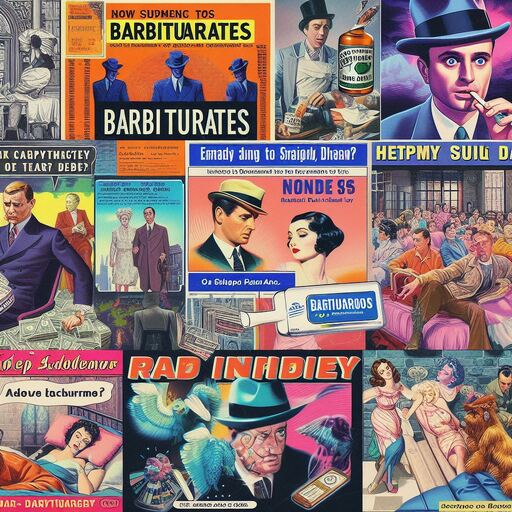Table of Contents
ToggleBarbiturates in Popular Culture
Barbiturates in Popular Culture
Barbiturates have had a significant yet complex role in popular culture, reflecting both their medical utility and their darker side as substances of abuse. From the golden age of Hollywood to the rock ‘n’ roll era, barbiturates have been a fixture in the backdrop of many narratives, both glorified and vilified. This article explores the journey of barbiturates through popular culture, highlighting their transition from ubiquitous medical panaceas to symbols of excess and downfall.
The Hollywood Connection: Glamour and Downfall
Barbiturates in Popular Culture
In the early to mid-20th century, barbiturates were commonly prescribed to help manage the pressures of Hollywood’s demanding schedules. Stars were often given “uppers” to stay awake and “downers,” such as barbiturates, to help them sleep, creating a cycle of dependency. The allure of these drugs was enhanced by their association with high-profile celebrities. For instance, the legendary actress Judy Garland was famously prescribed barbiturates from a young age, a practice that ultimately contributed to her lifelong struggle with addiction and her premature death.
Barbiturates became a symbol of the hidden struggles behind the glamorous façade of celebrity life. They were both a tool for maintaining the relentless pace of film production and a means of escape from the pressures of fame. This dual role made them a potent subject for media portrayal, reflecting broader societal attitudes about fame, mental health, and addiction.
Literature and Film: Mirroring Reality
Barbiturates have also been a recurrent theme in literature and film, where they are often used to highlight themes of despair, control, and rebellion. In literature, characters consuming barbiturates reflect real-world struggles with addiction, alienation, and societal pressure. For example, in Sylvia Plath’s “The Bell Jar,” the protagonist’s descent into mental illness is marked by her use of prescribed barbiturates, which she ultimately uses in her first suicide attempt. This portrayal underscores the dark side of a drug intended to soothe and stabilize.
Barbiturates in Popular Culture
In cinema, barbiturates have been depicted as both a quick fix for anxiety and a gateway to deeper troubles. Classic noir films often feature characters with hidden dependencies, while more contemporary movies might show the escalation from medical use to abuse, illustrating the drugs’ potent effects and the ease with which users can fall into hazardous patterns.
Music and the Counterculture
During the 1960s and 1970s, barbiturates seeped into the rock and roll and counterculture movements. Musicians and bands, living lifestyles marked by extreme highs and lows, turned to barbiturates for similar reasons as movie stars—managing sleep and maintaining the energy needed for their grueling schedules. The drugs were both celebrated and infamously remembered in songs and anecdotes, encapsulating the era’s spirit of rebellion and the personal toll it often demanded.
Barbiturates in Popular Culture
For instance, the Rolling Stones’ song “Mother’s Little Helper” deals directly with the burgeoning trend of drug use among housewives, with barbiturates being the “little yellow pill” that helped manage the day-to-day drudgery. This song highlighted not only the widespread use of these drugs but also pointed to the growing recognition of their dangers.
The Decline of Barbiturates in Medical Use
As the 20th century progressed, the medical community became increasingly aware of the risks associated with barbiturates—namely, their high potential for addiction and overdose. This led to the development of safer alternatives, such as benzodiazepines, which gradually replaced barbiturates in clinical settings. However, the cultural footprint of barbiturates remained, serving as a cautionary tale about the potential for misuse of prescription drugs.
Barbiturates in Popular Culture
Conclusion: A Reflection of Societal Attitudes
Barbiturates in popular culture offer a mirror to societal attitudes towards mental health, fame, and drug use. They exemplify how substances can be both medicinal and harmful, depending on their use and cultural context. As society continues to grapple with issues of drug abuse, dependency, and mental health, the story of barbiturates serves as a reminder of the need for compassion, understanding, and cautious management of pharmaceutical interventions. Their story is not just one of abuse or misuse but also a broader narrative about health, well-being, and the pressures of modern life.
